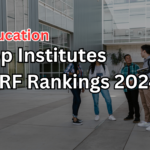The National Institutional Ranking Framework (NIRF) has become a cornerstone for evaluating the performance of higher education institutions in India. Released annually by the Ministry of Education, the rankings provide a comprehensive analysis of institutions based on a structured set of parameters. Here’s an in-depth look at how these rankings are determined using specific metrics.
Teaching, Learning & Resources (TLR)
1. Student Strength including Doctoral Students (SS): This metric evaluates the total student population, with an emphasis on the number of doctoral students, reflecting the academic diversity and depth of an institution.
2. Faculty-Student Ratio with Emphasis on Permanent Faculty (FSR): A balanced faculty-to-student ratio, focusing on permanent faculty, underscores the quality of teaching and mentoring available to students.
3. Combined Metric for Faculty with PhD (or Equivalent) and Experience (FQE): This parameter assesses the academic qualifications and professional experience of the faculty, ensuring that students are guided by knowledgeable and experienced educators.
4. Financial Resources and Their Utilisation (FRU): The efficient allocation and utilization of financial resources for academic infrastructure, research, and other educational activities are measured here.
Research and Professional Practice (RP)
1. Combined Metric for Publications (PU): The volume of research publications produced by the institution highlights its contribution to academia and innovation.
2. Combined Metric for Quality of Publications (QP): This evaluates the impact and quality of publications, measured through citations and other indicators.
3. IPR and Patents: Published and Granted (IPR): Institutions are assessed on the number of patents filed, published, and granted, showcasing their innovation and intellectual property contributions.
4. Footprint of Projects and Professional Practice (FPPP): The involvement in externally funded research projects and professional consultancy services reflects an institution’s active engagement with industry and society.
Graduation Outcomes (GO)
1. Metric for University Examinations (GUE): This focuses on the performance of students in university examinations, indicative of the academic standards upheld by the institution.
2. Metric for Number of Ph.D. Students Graduated (GPHD): The number of Ph.D. students graduating annually is a testament to the institution’s research output and mentorship quality.
Outreach and Inclusivity (OI)
1. Percentage of Students from Other States/Countries (Region Diversity RD): This parameter measures the diversity of the student body, with an emphasis on regional and international representation.
2. Percentage of Women (Women Diversity WD): The gender diversity of the student population is assessed, reflecting the institution’s commitment to inclusivity.
3. Economically and Socially Challenged Students (ESCS): Institutions are evaluated on their support for students from economically and socially disadvantaged backgrounds.
4. Facilities for Physically Challenged Students (PCS): The accessibility and support provided to differently-abled students are integral to this metric.
Perception (PR)
1. Peer Perception: This assesses the institution’s reputation among academic peers and employers. High perception scores often indicate strong academic and professional recognition.
A Comprehensive Evaluation
By integrating these metrics, NIRF rankings offer a holistic perspective of an institution’s performance. These parameters ensure that the rankings are fair, inclusive, and indicative of the true potential of institutions. As stakeholders increasingly rely on these rankings for decisions, they continue to play a vital role in shaping the future of education in India.


Average Rating